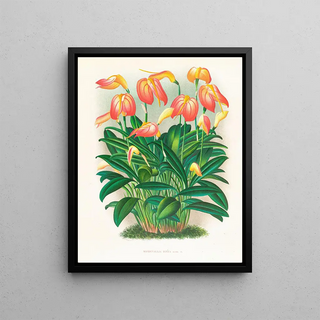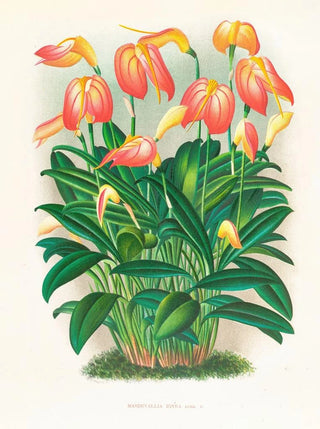Art print | Masdevallia est fougueux - Jean Jules Linden


View from behind

Frame (optional)
Art print Masdevallia is fiery - Jean Jules Linden – Captivating introduction
In the rich and complex world of floral art, the work "Masdevallia is fiery" by Jean Jules Linden stands out for its brilliance and delicacy. This painting, which celebrates the ephemeral beauty of flowers, evokes a universe where nature and art meet with striking harmony. Linden, botanist and artist, has captured the very essence of tropical flora, transforming fleeting moments into an eternal fixed on canvas. Immersing oneself in this piece, one is immediately transported to a lush garden, where each petal seems to vibrate with its own life.
Style and uniqueness of the work
Linden's work is characterized by meticulous attention to detail and a palette of vibrant colors that infuse his compositions with palpable energy. "Masdevallia is fiery" is no exception, where shades of green, yellow, and violet intertwine to create a lively tableau. Linden's technique, blending realism and impressionism, allows the flowers to appear both tangible and almost dreamlike. Every brushstroke is a tribute to natural beauty, and the artist manages to evoke not only the appearance of the flowers but also their essence, fragrance, and fragility. This work does not merely depict a frozen moment; it invites the viewer to feel the passion and energy that animate nature.
The artist and his influence
Jean Jules Linden, born in 1817, is an emblematic figure of the 19th century, not only as an artist but also as a botanist. His love for nature led him to travel around the world, collecting specimens and inspirations for his works. His work profoundly influenced the genre of botanical painting, redefining expectations and standards of the time. Linden's works are distinguished by their attention to detail and their ability to capture the fleeting beauty of plants. As an artist, he established a link between art and science, demonstrating that beauty can be both aesthetic and educational. His legacy endures, not only through his works but also in the inspiration he

Matte finish

View from behind

Frame (optional)
Art print Masdevallia is fiery - Jean Jules Linden – Captivating introduction
In the rich and complex world of floral art, the work "Masdevallia is fiery" by Jean Jules Linden stands out for its brilliance and delicacy. This painting, which celebrates the ephemeral beauty of flowers, evokes a universe where nature and art meet with striking harmony. Linden, botanist and artist, has captured the very essence of tropical flora, transforming fleeting moments into an eternal fixed on canvas. Immersing oneself in this piece, one is immediately transported to a lush garden, where each petal seems to vibrate with its own life.
Style and uniqueness of the work
Linden's work is characterized by meticulous attention to detail and a palette of vibrant colors that infuse his compositions with palpable energy. "Masdevallia is fiery" is no exception, where shades of green, yellow, and violet intertwine to create a lively tableau. Linden's technique, blending realism and impressionism, allows the flowers to appear both tangible and almost dreamlike. Every brushstroke is a tribute to natural beauty, and the artist manages to evoke not only the appearance of the flowers but also their essence, fragrance, and fragility. This work does not merely depict a frozen moment; it invites the viewer to feel the passion and energy that animate nature.
The artist and his influence
Jean Jules Linden, born in 1817, is an emblematic figure of the 19th century, not only as an artist but also as a botanist. His love for nature led him to travel around the world, collecting specimens and inspirations for his works. His work profoundly influenced the genre of botanical painting, redefining expectations and standards of the time. Linden's works are distinguished by their attention to detail and their ability to capture the fleeting beauty of plants. As an artist, he established a link between art and science, demonstrating that beauty can be both aesthetic and educational. His legacy endures, not only through his works but also in the inspiration he






